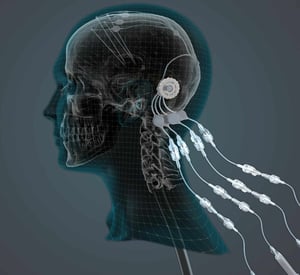Using robot-assisted surgery, 41 patients each had 4 catheters implanted into the area of the brain affected most by Parkinson’s, whereas the neurologists “assembled” a mini-tank of GDNF with a special micro-pump on the other end. Six patients participated in the initial pilot phase of the study, aimed at checking the safety of the device, whereas the other 35 wore the implant for nine months, randomly and blindly (i.e. without knowing what was being transfused into them) receiving either the growth factor or an inactive substance. At the end of the nine months all the patients were offered the possibility to receive the new therapy.
The results of the trial were difficult to interpret, as we have already said, because none of the sufferers treated had any clear benefit after the first nine months with regard to the symptoms of the disease. At the same time, however, investigations performed on the state of the brain showed that the condition of the most damaged nerve cells clearly improved in all the people treated with GDNF, with a 100% increase in the nerve cells that produce dopamine, the neurotransmitter that Parkinson sufferers are lacking (i.e. double the amount) .
After 18 months, i.e. when everyone had received the GDNF, both the groups experienced a modest to clear improvement in the symptoms of the disease, measured with internationally-recognized parameters.
The authors of the study call for caution, because in this phase all the patients knew that they had received the growth factor, and this may have had a significant (and positive) effect, from a psychological point of view, on their perception of the symptoms. Nevertheless, the researchers also highlight that the observed effects do not resemble any of the well-known effects that are obtained using standard therapies, especially from the perspective of the physiology of the nerve cells.
Furthermore, this study shows that restoring areas of the brain that have been lost due to neurodegeneration may be possible, and also that it is possible to transfuse a substance directly into the brain for many months without causing any particular problems. The latter discovery is considered to be of great importance, because many other drugs have trouble overcoming the blood-brain barrier (the “filter” that protects the brain) and therefore in many cases it is often impossible for the right therapies to reach nerve cells. The system developed by the British researchers could open the doors to new drug administration methods.
The results of the study have been published in the journal Brain (Oxford Academic), and in the Journal of Parkinson’s Disease. The new therapy tested by the British researchers is also the subject of a 6-part documentary series broadcast by the BBC.
“While the results are not clear-cut” says Arthur Roach, Director of Research at Parkinson’s UK, “the study has still been a resounding success. It has advanced our understanding of the potential effects of GDNF on damaged brain cells. All the partners involved – including the scientific team, companies, charities and patients – are continuing to work together to explore possible routes to further studies”.
Photo credits: MintMotion for Passionate Productions

